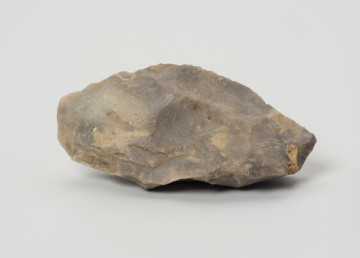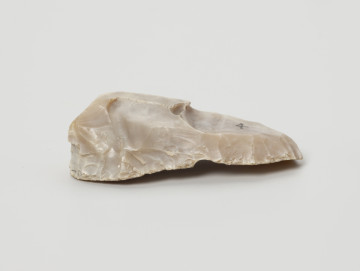
Core axe
7800 p.n.e. — 7000 p.n.e.
National Museum in Szczecin
Part of the collection: Stone Age
Scrapers are tools used to work with organic materials, primarily to clean leather before tanning. They are commonly found on archaeological sites dating back to almost the entire Stone Age. They have different forms, but what they have in common is the steep retouch that forms the working part. The presented piece from Smołdzino (Słupsk District) was created from a small flake, i.e. a piece of flint split from a larger fragment (flake) by placing it on a stone pad and pounding it with a pestle. This is the simplest and one of the oldest techniques used to work flint, hence it is not possible to determine the exact age of the tool described. The showcased relic was made of the Pomeranian flint, commonly known as "swallow breads". It is a variety of relatively young Baltic flint, approximately 65-62 million years old, found throughout Pomerania (abundantly on the Baltic coast) in the form of pebbles 2-5 cm in diameter, with black, heavily stripped and pitted bark. Inside, they range in colour from orange, honey and light yellow to various shades of grey to black. Due to their small size and often granular structure, they are difficult to work with, so prehistoric flint workers often subjected them to overheating, which significantly improved their properties. At the right temperature, the flint turned dark orange or red. Failure to stop this process in time, however, resulted in the colour changing to white, as exemplified by the piece on display, which, although red on the outside, turned white on the inside. The Smołdzino site, found on the dunes, was discovered in the late 19th century, where monuments dating to different periods of the Stone Age (Middle and Late Mesolithic as well as Late Neolithic) were found. Michał Adamczyk
Author / creator
Object type
scapers (flint tool)
Technique
hard-hammer knapping
Material
Pomeranian flint
Creation time / dating
Creation / finding place
Owner
Muzeum Narodowe w Szczecinie
Identification number
Location / status

7800 p.n.e. — 7000 p.n.e.
National Museum in Szczecin

12700 p.n.e. — 11500 p.n.e.
National Museum in Szczecin

11900 p.n.e. — 11000 p.n.e.
National Museum in Szczecin
DISCOVER this TOPIC
National Museum in Lublin
DISCOVER this PATH
Educational path